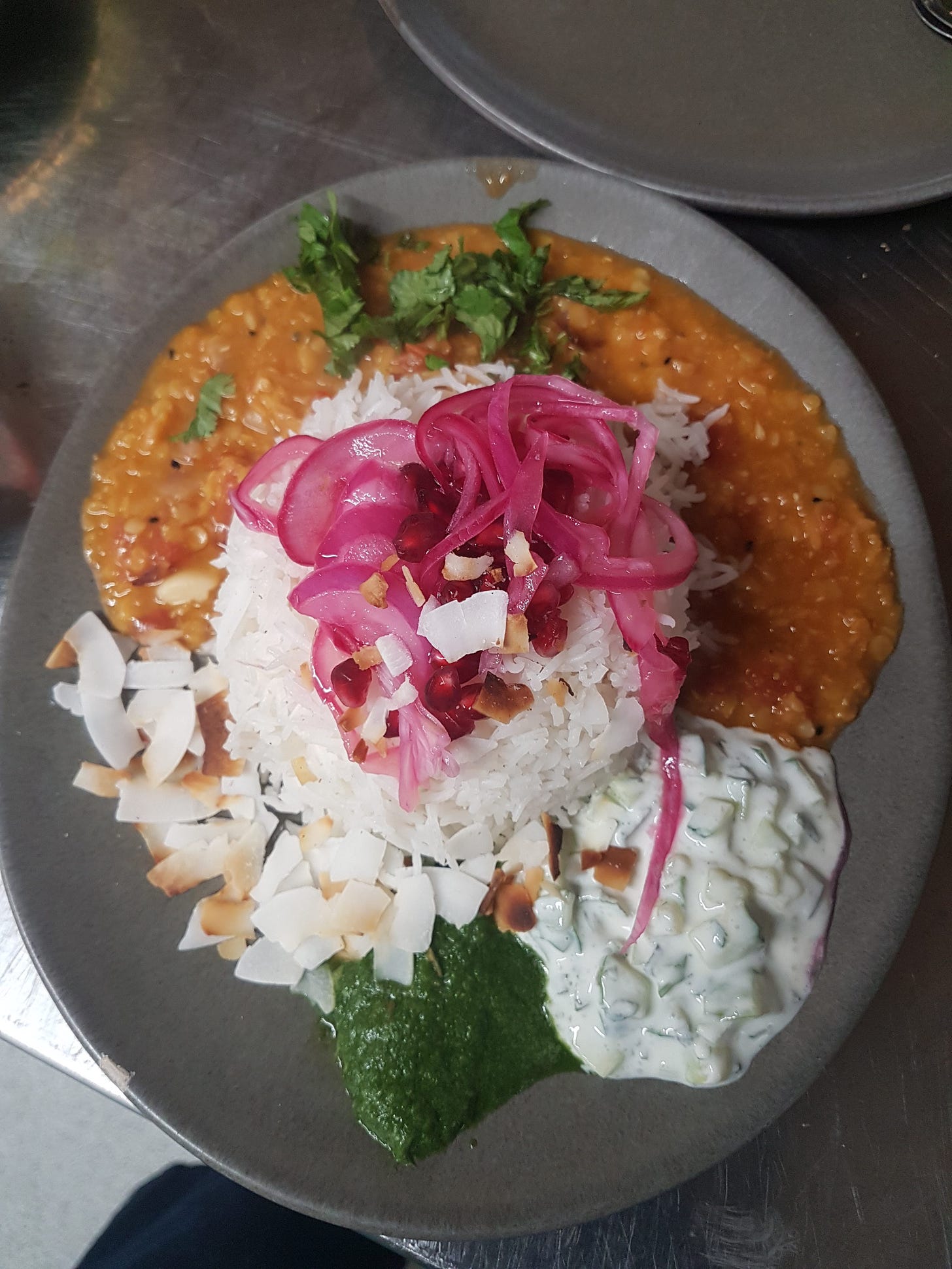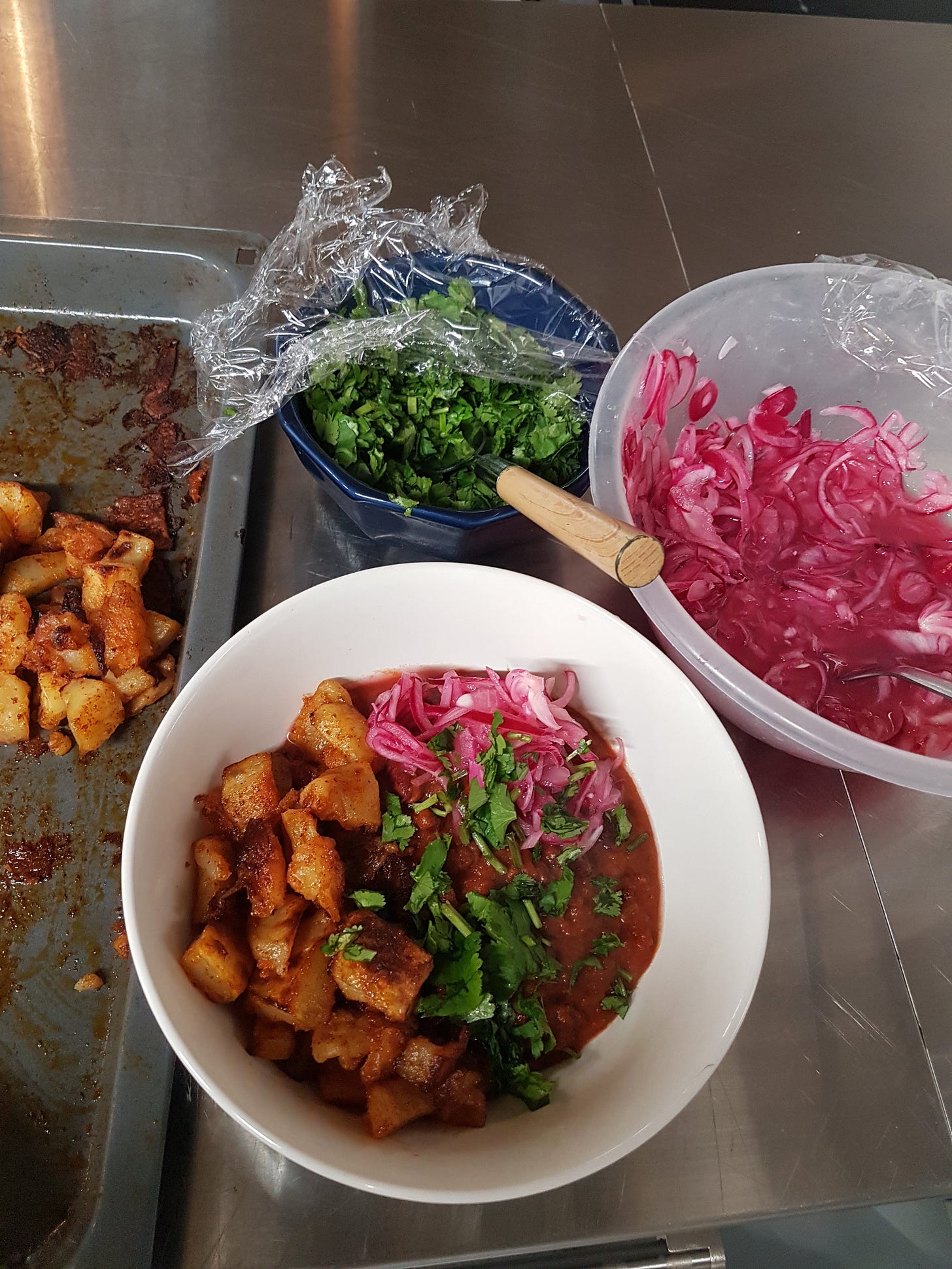Lentil dhal with rice, mint, cucumber and yoghurt raita, toasted coconut, green coriander chutney and pink pickled onions. Photo: Anne Richardson
I’ve been doing my weekly voluntary cooking work at South Norwood Community Kitchen for about a year-and-a-half now; time has literally galloped there. I wondered about writing up some of the recipes I make when I’m in, and realised that these might be massively impractical for a home cook. I’m usually cooking enough for around 50 people at a time, so have become so used to throwing in entire jars of spices, handfuls upon handfuls of chopped herbs, gallons of tinned tomatoes, entire blocks of butter and so on. Bechamel sauce for five giant lasagnes? Yup - use a whole 250g butter block and throw in enough flour to make a thick roux, then add about 4 litres of milk. Curry? More is more with the aromatic spicing for curries (in my opinion) - but I have to be super careful with the chilli as you don’t necessarily double up on heat in the same way as you might with, say, cumin. I made a few enormous spiced banana cakes containing approximately 25 mashed bananas each, which sounds ridiculous. The example below was about 5kg in weight.
Five spice banana cake. Photo: Anne Richardson
Mostly when I’m figuring out the big quantities for a lunch it feels as though I’m ‘winging it’ or judging things by eye as I make bigger versions of food I’ve cooked at home. I rarely use a written recipe as some of the ingredients I have to cook with materialise on the day itself, lurking at the back of one of the fridges. Surplus food gets donated to the cafe every Friday afternoon, so by the time my Friday morning cooking slot comes around, there’s barely any food left in the stores from the week, so I get a princely £20 budget to get things from the supermarket to bump things up. Fellow cooks help me out by texting a list of what’s available from the day before, but there are often treasures to unearth from the enormous fridge when I arrive, or unexpected shortages - several blocks of cheese might mysteriously vanish from the stores overnight, forcing me to make one block of cheddar stretch across five trays of cauliflower cheese. As I usually only cook vegetarian meals (and occasional pescatarian ones) I can stick to cheapish recipe ideas and have a few hacks to make things look special on the plate. In the case of the missing cheese, I used toasted seasoned breadcrumbs on top of the cauli cheese to add a bit of salty crunch. These were made from stale baguettes being thrown out by a local shop.
I am a big believer in getting as much nutrition onto the plate as possible, and as my food is veggie, it’s important to get enough protein into the recipe. I use a lot of pulses - chickpeas in curries and salads, red lentil dhals, white beans folded into stews, dark green small lentils hidden in mushroom bolognese sauce. I marinade tofu or paneer cheese and oven roast cubes of it for garnishing dishes. Herby yoghurt dips on the side. Fried eggs as toppings. I haven’t quite braved tempeh yet, as I find its texture quite dry and challenging. I often get asked by diners: “Where’s the meat?”, as it features heavily on the daily menus from Tuesday to Thursday as there are frequent donations of chicken wings from Nandos and huge sacks of mince. I sometimes get suspicious looks when I say that everything is veggie or vegan. But I rarely get any complaints after the dish has been eaten, and as the majority of diners coming to eat at SNCK are struggling financially, it’s important to me to get a lot of fresh veggies into everything, as fresh food is so expensive. There will always be a lot of garlic in everything, and where appropriate, masses of fresh ginger. Last Friday there was a random donation of fresh turmeric roots, so I used as much of that as was feasible in a lentil curry. My index fingers and thumbs stained with yellow juice as there were holes in my gloves!
Mexican black beans with roasted potatoes and pink pickled onions. Photo: Anne Richardson
When produce and money are tight, you can always rely on a few key garnishes to make a workaday veggie curry and rice look a bit special and exciting. I often make pink pickled onions to drape over the top of things - you can quickly assemble these onions (using a mandolin to slice saves time and makes beautiful slim slices) and they’re ready to eat after marinating for just an hour-and-a-half. They add a beautiful tangy bit of punch to a dish, and as they’ve been marinating you don’t get the acrid strong taste of raw onions lingering for hours after.
Pink pickled onions. Photo: Anne Richardson
Recipe: quick pink pickled onions - serves approx 30/40 as a garnish, or mixed into a fresh salad
Finely slice 8 red onions on a mandolin into a large bowl. Juice 6 lemons or 8 limes, add juice over the onions. Top up the citrus liquid with cider/white wine vinegar so that liquid reaches almost the top of the onions. Or, if you have an abundance of citrus, just add more citrus juice to the same level. Add 1/2 scant tablespoon salt. Mix, then (wearing gloves) scrunch the onions between your hands, to grind the salt and juice into them to soften them. Do this for a minute or so, until lots of pink juice emerges from the onions. Leave the onions to pickle for a minimum of 1 hour - the acrid taste of 'raw' onion will be neutralised. As an option: sprinkle in some fresh pomegranate seeds just before serving.








Another yum from me 🔆💛🔆